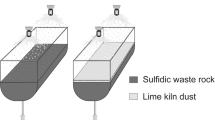Abstract
Backfilling of open pit with sulfidic waste rock followed by inundation is a common method for reducing sulfide oxidation after mine closure. This approach can be complemented by mixing the waste rock with alkaline materials from pulp and steel mills to increase the system’s neutralization potential. Leachates from 1 m3 tanks containing sulfide-rich (ca.30 wt %) waste rock formed under dry and water saturated conditions under laboratory conditions were characterized and compared to those formed from mixtures. The waste rock leachate produced an acidic leachate (pH < 2) with high concentrations of As (65 mg/L), Cu (6 mg/L), and Zn (150 mg/L) after 258 days. The leachate from water-saturated waste rock had lower concentrations of As and Cu (<2 μg/L), Pb and Zn (20 μg/L and 5 mg/L), respectively, and its pH was around 6. Crushed (<6 mm) waste rock mixed with different fractions (1–5 wt %) of green liquid dregs, fly ash, mesa lime, and argon oxygen decarburization (AOD) slag was leached on a small scale for 65 day, and showed near-neutral pH values, except for mixtures of waste rock with AOD slag and fly ash (5 % w/w) which were more basic (pH > 9). The decrease of elemental concentration in the leachate was most pronounced for Pb and Zn, while Al and S were relatively high. Overall, the results obtained were promising and suggest that alkaline by-products could be useful additives for minimizing ARD formation.



Similar content being viewed by others
References
Ahn JS, Chona C-M, Moona H-S, Kimb K-W (2003) Arsenic removal using steel manufacturing byproducts as permeable reactive materials in mine tailing containment systems. Water Res 37:2478–2488
Alpers CN, Blowes DW, Nordstrom DK, Jambor JL (1994) Secondary minerals and acid mine-water chemistry. In: Jambor JL, Blowes DW (eds) Environmental geochemistry of sulphide mine wastes. Mineralogical Association of Canada, Waterloo, Ontario, pp 247–270
Avfall Sverige (2009) http://www.avfallsverige.se/avfallshantering/ Last modified. Accessed 18 August 2012 (In Swedish)
Benzaazoua MM, Fall M, Belem T (2004) A contribution to understanding the hardening process of cemented pastefill. Miner Eng 17(2):141–152
Billerud (2010) Årsredovisning 2010 – Billerud skapar material för framtidens förpackningar. http://www.billerud.se/Documents/Cision/documents/2011/20110407-billeruds-arsredovisning-for-2010-offentliggjord-sv-2-561081.pdf Accessed 24 September 2012 (In Swedish)
Blowes DW, Jambor JL, Hanton-Fong CJ, Lortie L, Gould W (1998) Geochemical, mineralogical and microbiological characterization of a sulphide-bearing carbonate-rich gold-mine tailings impoundment. Appl Geochem 13:687–705
Cunha CS, Gahan CS, Menad N, Sandström Å (2009) Leaching behaviour of industrial oxidic of industrial oxidic by-products: possibilities to use as neutralization agent in bioleaching. Materials Science Forum 587–588:748–752
Davis JA, Leckie JO (1978) Effect of adsorbed complexing ligands on trace metal uptake by hydrous oxides. American Chem Soc 12:1309–1315
Dzombak DA, Morel FMM (1990) Surface complexation modeling; hydrous ferric oxides. Wiley, New York
European Commission (2013) Eurostat. Access 2013-01-25 from http://appsso.eurostat.ec.europa.eu/nui/show.do?dataset=env_wasgen&lang=en
Gazea B (1996) A review of passive systems for the treatment of acid mine drainage. Miner Eng 9:23–42
SCA Hållbarhetsredovisning (2009) <http://www.sca.com/Documents/sv/Env_Reports/SCA_Hallbarhetsredovisning_2009_SV.pdf> Accessed 18 August 2012 (In Swedish)
INAP - The International Network for Acid Prevention (2013) Last modified 2011-12-20. http://gardguide.com/index. Accessed 30 January 2013
Lapakko K. (2002) Metal mine rock and waste characterization tools: an overview
Mäkitalo M (2012) Green liquor dregs as sealing layer material to cover sulphidic mine waste deposits. Licentiate thesis. LUT Luleå ISSN: 1402–1757 ISBN:978-91-7439-473-3
Montelius C (2005) The Genetic Relationship between Rhyolitic Volcanism and Zn–Cu–Au. Deposits in the Maurliden Volcanic Centre. Skellefte district. Sweden: Volcanic facies. Litho- geochemistry and Geochronology. Doctoral Thesis 2005:17 ISSN:1402–1544. Luleå University of Technology
Nordstrom KD (2012) Mine waters: acidic to circumneutral. Elements: 7:393–398
Peppas A, Komnitsas K, Halikia I (2000) Use of organic covers for acid mine drainage control. Miner Eng 13:563–574
Salmon SU, Malmström ME (2002) MiMi-steady state, geochemical box model of tailings impoundment. Application to impoundment 1, Kristineberg, Sweden, and prediction of effect of remediation MiMI 2002:2
Scippers A (2004) Biogeochemistry of metals sulfide oxidation in mining environments, sediments, and soils. In: Amend JP, Edwards KJ, Lyons TW (eds) Sulfur geochemistry past and present. The Geological Society of America, Boulder, CO
Swedish Agency of Environmental Protection (SEPA) (2010) http://www.naturvardsverket.se, Accessed 18 August 2012 (In Swedish)
Author information
Authors and Affiliations
Corresponding author
Additional information
Responsible editor: Philippe Garrigues
Rights and permissions
About this article
Cite this article
Alakangas, L., Andersson, E. & Mueller, S. Neutralization/prevention of acid rock drainage using mixtures of alkaline by-products and sulfidic mine wastes. Environ Sci Pollut Res 20, 7907–7916 (2013). https://doi.org/10.1007/s11356-013-1838-z
Received:
Accepted:
Published:
Issue Date:
DOI: https://doi.org/10.1007/s11356-013-1838-z




